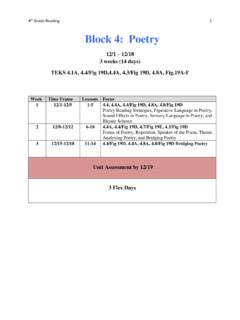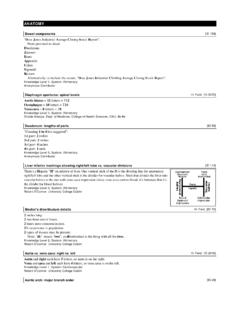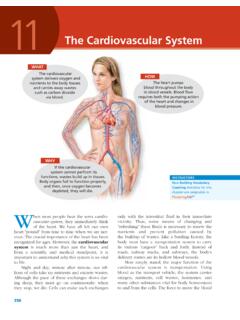Transcription of ANATOMY OF THE CARDIOVASCULAR SYSTEM
1 CHAPTER 18. ANATOMY . OF THE. CARDIOVASCULAR . SYSTEM . CHAPTER OUTLINE KEY TERMS. Heart, 556 anastomosis myocardium Location of the Heart, 556 arteriole pericardium Size and Shape of the Heart, 557 artery pulmonary circulation Coverings of the Heart, 557 atrium systemic circulation Structure of the Heart Coverings, 557 capillary vein Function of the Heart Coverings, 557 endocardium ventricle Structure of the Heart, 559 endothelium venule Wall of the Heart, 559 epicardium Chambers of the Heart, 560. Valves of the Heart, 561. T. Blood Supply of Heart Tissue, 563. Conduction SYSTEM of the Heart, 565. he CARDIOVASCULAR SYSTEM is sometimes called, simply, Nerve Supply of the Heart, 565 the circulatory SYSTEM . It consists of the heart, which is Blood Vessels, 566 a muscular pumping device, and a closed SYSTEM of Types of Blood Vessels, 566 vessels called arteries, veins, and capillaries. As the name im- Structure of Blood Vessels, 566 plies, blood contained in the circulatory SYSTEM is pumped Outer Layer, 566 by the heart around a closed circle or circuit of vessels as it Middle Layer, 567 passes again and again through the various circulations of Inner Layer, 567 the body (on p.)
2 569). Functions of Blood Vessels, 567 As in the adult, survival of the developing embryo de- Functions of Capillaries, 567 pends on the circulation of blood to maintain homeostasis Functions of Arteries, 568. and a favorable cellular environment. In response to this Functions of Veins, 568. Major Blood Vessels, 569. need, the CARDIOVASCULAR SYSTEM makes its appearance early Circulatory Routes, 569 in development and reaches a functional state long before Systemic Circulation, 569 any other major organ SYSTEM . Incredible as it seems, the Systemic Arteries, 569 heart begins to beat regularly early in the fourth week after Systemic Veins, 573 fertilization. Fetal Circulation, 581. Cycle of Life, 584 HEART. The Big Picture, 584. Mechanisms of Disease, 584 LOCATION OF THE HEART. Case Study, 589 The human heart is a four-chambered muscular organ, shaped and sized roughly like a person's closed fist. It lies in the mediastinum, or middle region of the thorax, just be- hind the body of the sternum between the points of attach- 556.
3 ANATOMY of the CARDIOVASCULAR SYSTEM Chapter 18 557. In the adult the shape of the heart tends to resemble that of the chest. In tall, thin individuals the heart is frequently described as elongated, whereas in short, stocky individuals it has greater width and is described as transverse. In indi- viduals of average height and weight it is neither long nor transverse but somewhat intermediate between the two (Figure 18-1). Its approximate dimensions are length, 12 cm (43 4 inches); width, 9 cm (31 2 inches); and depth, 6 cm (21 2 inches). Figure 18-2 shows details of the heart and great vessels in a posterior view and in an anterior view. COVERINGS OF THE HEART. Structure of the Heart Coverings The heart has its own special covering, a loose-fitting inex- Figure 18-1 Appearance of the heart. This photograph shows a tensible sac called the pericardium. The pericardial sac, with living human heart prepared for transplantation into a patient.
4 Notice the heart removed, can be seen in Figure 18-3. The peri- its size relative to the hands that are holding it. cardium consists of two parts: a fibrous portion and a serous portion (Figure 18-4). The sac itself is made of tough white fibrous tissue but is lined with smooth, moist serous membrane the parietal layer of the serous pericardium. ment of the second through the sixth ribs. Approximately The same kind of membrane covers the entire outer surface two thirds of the heart's mass is to the left of the midline of of the heart. This covering layer is known as the visceral layer the body and one third to the right. of the serous pericardium or as the epicardium. The fibrous Posteriorly the heart rests against the bodies of the fifth to sac attaches to the large blood vessels emerging from the top the eighth thoracic vertebrae. Because of its placement be- of the heart but not to the heart itself (see Figure 18-3). tween the sternum in front and the bodies of the thoracic Therefore it fits loosely around the heart, with a slight space vertebrae behind, it can be compressed by application of between the visceral layer adhering to the heart and the pari- pressure to the lower portion of the body of the sternum us- etal layer adhering to the inside of the fibrous sac.
5 This space ing the heel of the hand. Rhythmic compression of the heart is called the pericardial space. It contains (10 to 15 ml) of lu- in this way can maintain blood flow in cases of cardiac arrest bricating fluid secreted by the serous membrane and called and, if combined with effective artificial respiration, the re- pericardial fluid. sulting procedure, called cardiopulmonary resuscitation The structure of the pericardium can be summarized as (CPR), can be life saving. follows: The anatomical position of the heart in the thoracic cav- ity is shown in Figure 18-9. The lower border of the heart, Fibrous pericardium tough, loose-fitting, and inelastic which forms a blunt point known as the apex, lies on the di- sac around the heart aphragm, pointing toward the left . To count the apical beat, Serous pericardium consisting of two layers one must place a stethoscope directly over the apex, that is, Parietal layer lining inside of the fibrous in the space between the fifth and sixth ribs (fifth intercostal pericardium space) on a line with the midpoint of the left clavicle.
6 Visceral layer (epicardium) adhering to the outside The upper border of the heart, that is, its base, lies just be- of the heart; between visceral and parietal layers is a low the second rib. The boundaries, which, of course, indi- space, the pericardial space, which contains a few cate its size, have considerable clinical importance, because a drops of pericardial fluid marked increase in heart size accompanies certain types of heart disease. Therefore when diagnosing heart disorders, Function of the Heart Coverings the physician charts the boundaries of the heart. The nor- The fibrous pericardial sac with its smooth, well-lubricated mal boundaries of the heart are, however, influenced by lining provides protection against friction. The heart moves such factors as age, body build, and state of contraction. easily in this loose-fitting jacket with no danger of irritation from friction between the two surfaces, as long as the serous SIZE AND SHAPE OF THE HEART pericardium remains normal and continues to produce lu- At birth the heart is said to be transverse (wide) in type and bricating serous fluid.
7 Appears large in proportion to the diameter of the chest cav- ity. In the infant, it is 1 130 of the total body weight compared to about 1 300 in the adult. Between puberty and 25 years 1. In anatomical terms, where is the heart located? 2. Name the layers of tissue that make up the pericardium. of age the heart attains its adult shape and weight about 3. What is the function of the pericardium? 310 g is average for the male and 225 g for the female. 558 Unit 4 Transportation and Defense A brachiocephalic trunk left common carotid artery Superior left subclavian artery vena cava Arch of aorta Pulmonary trunk Ligamentum arteriosum Ascending aorta Auricle of left atrium Conus arteriosus left pulmonary veins Right pulmonary veins Great cardiac vein Auricle of Anterior interventricular right atrium branch of left coronary artery and cardiac vein Right coronary artery and cardiac vein left ventricle S. R L. Apex I Right ventricle B left common carotid artery left subclavian artery brachiocephalic trunk Aortic arch Superior vena cava left pulmonary artery Right pulmonary artery left pulmonary veins Right pulmonary veins Auricle of left atrium left atrium Right atrium Great cardiac vein Inferior vena cava Posterior artery Coronary sinus and vein of left ventricle Posterior interventricular branch of right coronary left ventricle artery S.
8 Middle cardiac vein R L. Right ventricle I Apex Posterior interventricular sulcus Figure 18-2 The heart and great vessels. A, Anterior view of the heart and great vessels. B, Posterior view of the heart and great vessels. ANATOMY of the CARDIOVASCULAR SYSTEM Chapter 18 559. Fatty connective Serous pericardium OUTSIDE tissue (visceral layer;. OF epicardium). HEART. Coronary artery and vein Fibrous INSIDE. pericardium OF. HEART. Serous pericardium (parietal layer). Right brachiocephalic Pericardial space artery Myocardium Trabeculae Right brachiocephalic vein Endocardium left brachiocephalic vein Line of attachment of Superior fibrous pericardium vena Descending and reflection of cava aorta serous pericardium Right left pulmonary pulmonary artery Fibrous veins pericardium Pulmonary trunk Serous left pulmonary pericardium: veins Visceral Parietal Pericardial Esophageal space prominence S. R L Diaphragm S. I R L Fibrous pericardium Fibrous pericardium fused with diaphragm loosely attached Inferior vena cava I at central tendon to diaphragm Figure 18-3 Pericardium.
9 This frontal view shows the pericardial Figure 18-4 Wall of the heart. This section of the heart wall shows sac with the heart removed. Notice that the pericardial sac attaches to the fibrous pericardium, the parietal and visceral layers of the serous the large vessels that enter and exit the heart, not to the heart itself. pericardium (with the pericardial space between them), the myocardium, and the endocardium. Notice that there is fatty connective tissue between the visceral layer of the serous pericardium (epicardium) and the myocardium. Notice also that the endocardium covers beamlike projections of myocardial muscle tissue, called trabeculae. STRUCTURE OF THE HEART Myocardium. The bulk of the heart wall is the thick, con- Wall of the Heart tractile, middle layer of specially constructed and arranged Three distinct layers of tissue make up the heart wall (see cardiac muscle cells called the myocardium. The minute Figure 18-4) in both the atria and the ventricles: the epi- structure of cardiac muscle has been described in Chapters 5.
10 Cardium, myocardium, and endocardium. and 11. Recall that cardiac muscle tissue is composed of many branching cells that are joined into a continuous mass Epicardium. The outer layer of the heart wall is called the by intercalated disks (Figure 18-5). Because each intercalated epicardium, a name that literally means on the heart. The disk includes many gap junctions, large areas of cardiac epicardium is actually the visceral layer of the serous muscle are electrically coupled into a single functional unit pericardium already described. In other words, the same called a syncytium (meaning joined cells ). Because they structure has two different names: epicardium and serous form a syncytium, muscle cells can pass an action potential pericardium. along a large area of the heart wall, stimulating contraction 560 Unit 4 Transportation and Defense in each muscle fiber of the syncytium. Another advantage of cular myocardium can contract powerfully and rhythmi- the syncytium structure is that the cardiac fibers form a con- cally, without fatigue, the heart is an efficient and depend- tinuous sheet of muscle that wraps entirely around the cavi- able pump for blood.











